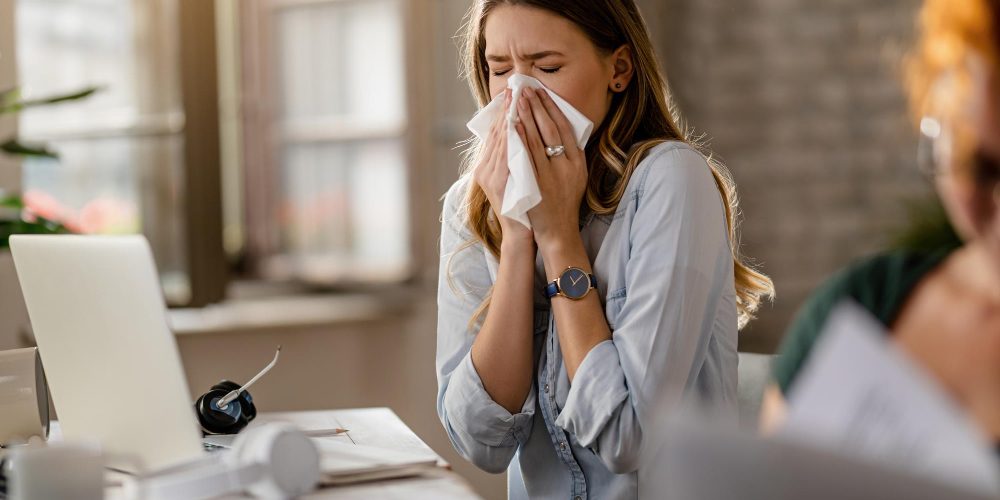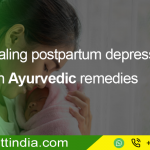What are allergies then?
Ayurveda says that an allergy happens when an allergen makes a certain Dosha (Vata, Pitta, or Kapha) worse.
Ayurveda talks about allergies in terms of the doshas, depending on which one is affected in each case.
The person who is mostly pitta is more likely to get a pitta type of allergy, while the person who is mostly kapha is more likely to get a kapha type.
Let’s take a look at the three types of allergies that the ancient Ayurvedic doctors identified:
Vata-Type Allergies
Vata allergies usually affect the digestive tract and cause symptoms like burping, stomach pain, gurgling intestines, abdominal pain, wheezing, headache, sneezing, sciatica, muscle spasms, and other Vata-type discomforts.
Vata imbalances can make you sensitive to raw foods, many beans (like black beans, pinto beans, etc.), and some animal proteins, like pork.
Balancing Vata
When Vata is upset, it’s important to slow down, stay warm, stay hydrated, and eat a diet that calms Vata. Vata allergies can often be helped by drinking ginger or liquorice tea with a drop of ghee. Since Vata lives in the colon, a Dashamula tea enema is a very good way to balance allergies that are caused by Vata.
Pitta-Type Allergies
Most Pitta allergies happen when the allergen touches the skin and slowly makes its way into the blood. Pitta-type allergies usually cause skin reactions like itching, allergic dermatitis, eczema, rashes, and bloodshot eyes. Pitta allergies can also lead to heartburn, acid reflux, stomach problems, feeling sick, or even throwing up.
Pitta can make you sensitive to foods like hot, spicy foods, citrus fruits, tomatoes, and foods that have been fermented.
Balancing Pitta
For Pitta-type allergies, it’s best to eat foods that calm Pitta. Natural formulas that support the blood, like a mix of Manjistha and Neem, can also be helpful. Mix one part Manjistha with one part Neem. Take a half teaspoon of the mixture in warm water after each meal, three times a day.
Kapha Type Allergies
Pollen-based allergens are most likely to cause Kapha type allergies. Mucous membrane irritation, hay fever, colds, congestion, sinus infections, bronchial congestion, asthma, and even trouble sleeping are some of the signs. Kapha can make people allergic to dairy foods like milk, yoghurt, and cheese.
Balancing Kapha
Keep warm and dry, stay active, and eat foods that are good for Kapha. Kapha can be gotten rid of with teas that clear the mind, like ginger, cinnamon, cardamom, etc. Using honey from your own area as a sweetener helps to clean out your body. Trikatu tablets can also be used to help. Also, Punarnava is very good at getting rid of excess Kapha from the chest and stomach, which helps keep the tissues’ fluid balance right.
Panchakarma is also a very good way to get rid of Kapha that has built up in the body.
Here are some good ways that ayurveda can help stop allergies:
- Use a Neti pot filled with distilled water and a weak salt solution to loosen up Kapha. This also helps get rid of allergens that might be stuck to the mucous membranes.
- Nasya: About an hour after using the neti pot, put a small amount of sesame oil with eucalyptus or camphor in each nostril.
- Take Trikatu, a mixture of black pepper, long pepper, and ginger, before meals to heat the Agni (digestive fire).
- Avoid cold foods and drinks, like dairy, wheat, meat, and iced drinks, because they can slow down digestion and dampen the Agni. Eat cooked foods that are warm, light, natural, and easy to digest. Focus on fruits and vegetables that are fresh and organic. To make the mucous membranes feel better, cook vegetables with a little bit of ghee or olive oil.
- Ginger tea is good to drink all day because it helps the digestive fire. Take Triphala tablets at night to help get rid of excess toxins that can slow digestion. Amalaki, Haritaki, and Bibtaki, which come from fruits and are used in Ayurvedic medicine, work to clean and strengthen the body. Every day, you should exercise to help stimulate Agni and get rid of Ama.
At ‘Matt India’ people with many different kinds of illnesses can get help. This old way of healing is very natural and takes care of the whole person. Ayurveda has many more benefits than just pain relief. The type of treatment is customised and uses age-old practises as part of a daily (Dinacharya) and seasonal (Ritucharya) routine to help heal illnesses and keep them from coming back.
Tags : Panchakarma, Rejuvenation, Ayurveda Packages, Ayurveda Therapy in Kerala, Ayurveda Tips to Beat Allergies








